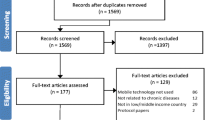Abstract
Analyzation of the use of Mobile Health (mHealth) applications in different user groups in order to evaluate the potential that mHealth provides for the prevention of non-communicable diseases (NCD). Cross-sectional online survey with 1119 participants in Switzerland. Forty percent used mHealth applications. Most participants used mHealth to promote their health (70%), influence a specific aspect of their health (59%) and monitor their fitness level (61%). mHealth was used more often by people suffering from NCD (p<0.05) and participants older than fifty years did not use mHealth less than younger participants (p>0.05). Trust in the collected data was high (93%), however, participants rarely relied on scientific recommendation for choosing mHealth applications (14%) and only the minority discussed the data with a physician (19%). The majority saw advantages in using mHealth for the prevention of NCD (62%) and providing patients with the possibility to control their lifestyle changes (59%). mHealth is used across all age groups and significantly more often by people suffering from NCD. However, the collected data is not evaluated systematically. We suggest the inclusion of mHealth into the health care plan to increase patient empowerment to beneficially affect the development of NCD.
Similar content being viewed by others
References
WHO | Deaths from NCDs, WHO. http://www.who.int/gho/ncd/mortality_morbidity/ncd_total/en/ (accessed 9 Nov 2019).
Bundesamt für Gesundheit, Faktenblatt NCD, (2016).
Preventing noncommunicable diseases. https://www.who.int/activities/preventing-noncommunicable-diseases (accessed 9 Nov 2019).
World Health Organization. Action Plan for the Prevention and Control of Noncommunicable Diseases in the WHO European Region, 39.
World Health Organization. New horizons for health through mobile technologies, 2011. https://www.who.int/goe/publications/goe_mhealth_web.pdf.
Research2Guidance, mHealth Developer Economics 2017, (2017).
Number of smartphone users worldwide 2014-2020, Statista. 2019. https://www.statista.com/statistics/330695/number-of-smartphone-users-worldwide/ (accessed 6 Dec 2019).
Global mHealth app downloads 2013-2017, Statista. (2019). https://www.statista.com/statistics/625034/mobile-health-app-downloads/ (accessed 6 Dec 2019).
World Health Organization. Global action plan for the prevention and control of noncommunicable diseases: 2013-2020., 2013. http://apps.who.int/iris/bitstream/10665/94384/1/9789241506236_eng.pdf (accessed 9 Dec 2019).
Messner E-M, Probst T, O’Rourke T, Stoyanov S, Baumeister H. mHealth Applications: Potentials, Limitations, Current Quality and Future Directions, in: H. Baumeister, C. Montag (Eds.), Digit. Phenotyping Mob. Sens. New Dev. Psychoinformatics, Springer International Publishing, Cham, 2019:235–248. https://doi.org/10.1007/978-3-030-31620-4_15.
Beratarrechea A, Lee AG, Willner JM, Jahangir E, Ciapponi A, Rubinstein A. The Impact of Mobile Health Interventions on Chronic Disease Outcomes in Developing Countries: A Systematic Review. Telemed E-Health. 2014;20:75–82. https://doi.org/10.1089/tmj.2012.0328.
Marcolino MS, Oliveira JAQ, D’Agostino M, Ribeiro AL, Alkmim MBM, Novillo-Ortiz D. The Impact of mHealth Interventions: Systematic Review of Systematic Reviews. JMIR MHealth UHealth. 2018;6:e23. https://doi.org/10.2196/mhealth.8873.
Milani RV, Bober RM, Lavie CJ. The Role of Technology in Chronic Disease Care. Prog Cardiovasc Dis. 2016;58:579–83. https://doi.org/10.1016/j.pcad.2016.01.001.
Piette JD, List J, Rana GK, Townsend W, Striplin D, Heisler M. Mobile Health Devices as Tools for Worldwide Cardiovascular Risk Reduction and Disease Management. Circulation. 2015;132:2012–27. https://doi.org/10.1161/CIRCULATIONAHA.114.008723.
Bendig E, Bauereiß N, Ebert DD, Snoek F, Andersson G, Baumeister H. Internet-based interventions in chronic somatic disease. Dtsch Aerzteblatt Online. 2018. https://doi.org/10.3238/arztebl.2018.0659.
Loo JL. Acceptance of health services on mobile phones: A study of consumer perceptions, 203.
Torous J, Friedman R, Keshavan M. Smartphone Ownership and Interest in Mobile Applications to Monitor Symptoms of Mental Health Conditions. JMIR MHealth UHealth. 2014;2:e2. https://doi.org/10.2196/mhealth.2994.
Dennison L, Morrison L, Conway G, Yardley L. Opportunities and Challenges for Smartphone Applications in Supporting Health Behavior change: Qualitative Study. J Med Internet Res. 2013;15:e86. https://doi.org/10.2196/jmir.2583.
Terhorst Y, Rathner E-M, Baumeister H, Sander L. «Hilfe aus dem App-Store?»: Eine systematische Übersichtsarbeit und Evaluation von Apps zur Anwendung bei Depressionen. Verhaltenstherapie. 2018;28:101–12. https://doi.org/10.1159/000481692.
Jusoh S. A Survey on Trend, Opportunities and Challenges of mHealth Apps. Int J Interact Mob Technol IJIM. 2017;11:73. https://doi.org/10.3991/ijim.v11i6.7265.
Chow CK, Ariyarathna N, Islam SMS, Thiagalingam A, Redfern J. mHealth in Cardiovascular Health Care. Heart Lung Circ. 2016;25:802–7. https://doi.org/10.1016/j.hlc.2016.04.009.
Bundesamt für Gesundheit, Sprachen https://www.bfs.admin.ch/bfs/de/home/statistiken/bevoelkerung/sprachen-religionen/sprachen.html (accessed 5 Dec 2019).
Funding
This research did not receive any specific grant from funding agencies in the public, commercial, or not-for-profit sectors.
Author information
Authors and Affiliations
Contributions
MZ: Data analysis, manuscript writing. CW: Data collection. US: Data management. PS: Project development, manuscript editing.
Corresponding author
Ethics declarations
Ethical approval
As this survey was both voluntary and anonymous, approval by the cantonal ethic committee was not necessary. A jurisdictional inquiry at the ethical committee confirmed this (KEK Req-2018-00731).
Consent to participate and for publication
The survey was voluntary, all participants were aware of participating in a study.
Informed consent
As this survey was both voluntary and anonymous, obtaining of informed consent was not necessary. A jurisdictional inquiry at the ethical committee confirmed this (KEK Req-2018-00731).
Conflict of interest:
The authors declare that they have no conflicts of interest.
Supplementary Information
Below is the link to the electronic supplementary material.
Rights and permissions
About this article
Cite this article
Zangger, M., Wälchli, C., Stefenelli, U. et al. The use of mobile health applications for the prevention of non-communicable diseases. Health Technol. 11, 585–593 (2021). https://doi.org/10.1007/s12553-021-00536-8
Received:
Accepted:
Published:
Issue Date:
DOI: https://doi.org/10.1007/s12553-021-00536-8




